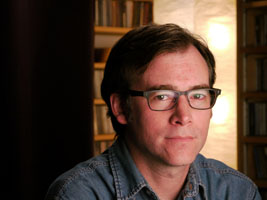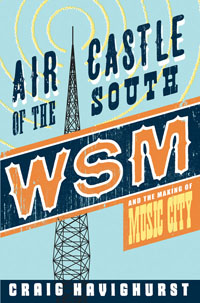Spin through your AM dial through the static past the squeals and squawks, past the end-timer rants and the political talk. Eventually you’ll tune into 650AM, the home of WSM Radio. There you might hear some vintage Loretta Lynn or contemporary Brad Paisley, perhaps a commercial for the car dealership down the road. Maybe you’ll catch an interview between Eddie Stubbs and an up-and-coming singer. Regardless, you’re listening to a signal that’s been going strong for the better part of a century, a signal that helped create Music City’s very identity and broadcast the culture of country music to the entire world. And that signal has a remarkable story. Craig Havighurst’s Air Castle of the South: WSM and the Making of Music City, newly released in paperback, follows an extraordinary group of artists, engineers, and managers as they created a broadcasting legend from the ground up.
 Havighurst captures in remarkable detail the early days of country radio and guides readers through the growth of WSM from its AM origins to its enormous influence as The Nashville Network. In connection with the paperback release of Air Castle of the South: WSM and the Making of Music City, Havighurst will speak at Parnassus Books on May 23, 2013. Prior to the event, he answered questions from Chapter 16 via email:
Havighurst captures in remarkable detail the early days of country radio and guides readers through the growth of WSM from its AM origins to its enormous influence as The Nashville Network. In connection with the paperback release of Air Castle of the South: WSM and the Making of Music City, Havighurst will speak at Parnassus Books on May 23, 2013. Prior to the event, he answered questions from Chapter 16 via email:
Chapter 16: Though Opry artists are certainly a presence, the real stars of Air Castle of the South are the men and women behind the curtain—people like engineer and broadcasting pioneer, Jack DeWitt. Were they aware at the time of how broadly their station was influencing American culture?
Craig Havighurst: I’m speculating a bit here because even living figures have a hard time answering that question. But I’d say that in the 30s and 40s, DeWitt, Harry Stone, Edwin Craig, and other leading executives at WSM knew they were running one of the most respected and professional radio stations in the country. They knew they were getting fan mail from all parts of the U.S. and sometimes Canada and Cuba. They knew they had a hit star-making show in the Grand Ole Opry and that they were regularly called on by NBC to provide shows and news coverage for the national network. They also took steps to solidify WSM as a power player in the radio industry. But since country music was such a niche, and often a maligned one at that, there’s no way they could have imagined that they were setting the table for a really big business or music genre decades later. They would have simply been aware of their impact as major players in contemporary national entertainment, and they kept their standards very high as a result.
Chapter 16: For years there were tensions between the Nashville elite and the country-music crowd, “Athens of the South” vs. “Music City USA.” How did the WSM executives, with a foot in each camp, deal with those tensions?
Havighurst: Gingerly. In the first five years of the Opry, there was discussion at the station and in town about whether its “hillbilly” music show should be renewed. As it became established on Saturday nights as an important show, WSM was still reluctant to program country music the rest of the week. Edwin Craig was frequently ribbed by Belle Meade friends about his low-brow show on his otherwise sophisticated radio station. But Craig always appreciated and defended what he thought of as folk music. And his hand-picked program director, George D. Hay, also believed in the importance and popularity of country music. Finally in the 1940s, WSM began allowing early-morning shows to include Opry/country artists because they were so popular with rural listeners, and advertisers wanted to sell them feed, baby chicks, and flour.
 Chapter 16: There were dozens of wildly popular “barn dances” on the airwaves during the twentieth century: The National Barn Dance in Chicago, The Louisiana Hayride out of Shreveport, Renfro Valley out of Kentucky. Most were off the air by the early seventies. What gave the Opry its staying power?
Chapter 16: There were dozens of wildly popular “barn dances” on the airwaves during the twentieth century: The National Barn Dance in Chicago, The Louisiana Hayride out of Shreveport, Renfro Valley out of Kentucky. Most were off the air by the early seventies. What gave the Opry its staying power?
Havighurst: That would take more knowledge of the other operations than I have, but one easy answer is simply that by the 1940s, the Opry was the biggest and most influential of the barn dances, and it never lost its prime position. By the 50s and 60s, the growth of the recording and publishing business in Nashville became an even greater magnet for artists to come try their hand and stay, if and when they made it. And it was the cumulative impact of WSM’s other, non-country shows and overall professionalism that made the Opry grow so robustly. Not to mention happy accidents like the Ryman Auditorium, which was hard to beat as a venue.
Chapter 16: You note that, historically, WSM saw itself as a patron of the local creative economy, supporting an untold number of musicians and technical crews over the years. Such patronage seems utterly foreign today. How common was that attitude among corporations at the time?
Havighurst: I would love to know the answer to that question. When I uncovered National Life/WSM promotional copy bragging about employing live musicians and cultivating a music ecosystem (my word choice) in Nashville, I was floored. I’d never seen such rhetoric attached to an entertainment company, let alone an insurance company! I’d only ever seen arts patronage from companies as grants to major cultural high-brow institutions like operas or symphonies. The idea that National Life would spend so liberally on live talent in vernacular music and make that a selling point to sponsors and even the FCC (which renewed broadcast licenses based on a commitment to public service) still stands alone in my experience.
And there, I think, is the core reason WSM kickstarted a self-sustaining chain reaction that made a music industry here. It’s important to remember too that this commitment continued all the way through the operation of Opryland USA, which never used recorded tracks. They hired hundreds of musicians from around the country every year, and many of them stayed in Nashville and became part of the industry.
Chapter 16: We almost lost WSM about a decade ago, when new management thought a sports-talk format would be more profitable. But for the ensuing PR disaster (public outcry amplified by local celebrities), that’s exactly what would’ve happened. How can WSM continue to maintain its traditional identity in such a volatile media landscape?
Havighurst: WSM has two “traditional identities”—its historic role as a top-flight, all-around radio station projecting Nashville to the nation and its latter-day role as a classic country-radio station preserving traditional country music, an identity it only took on in the late 70s and 80s. The radio business has changed so much that WSM’s historic strengths—abundant live programming, major news operation—would be unaffordable on the AM dial of 2013.
The station has tried, sometimes more aggressively than others, to become a taste-maker in classic country/Americana music, which feels like the most natural role it could play today. But it always feels like WSM is an afterthought in owner Gaylord’s mind, compared to the Grand Ole Opry or the Ryman Auditorium. Personally, I’d spin WSM off as a nonprofit that positioned itself like living history, much like Hatch Show Print has done. Historic but hip. Very plugged into Nashville’s emerging Americana and traditional country. Lots of bluegrass. I’d get out of the ratings game and shift from a spot-advertising model to a partner/underwriter model. Whatever allows maximum freedom to program music that respects Nashville’s past and future.
Chapter 16: Last question: should Hank be reinstated into the Opry?
Havighurst: Seems a little late for that. I don’t see the Opry as a Hall of Fame, and I don’t think posthumous membership in a live weekly show would have much point. Hank doesn’t lack for respect or institutions that preserve his music and story.
Craig Havighurst will discuss Air Castle of the South at Parnassus Books in Nashville on May 23, 2013, at 6:30 p.m.





